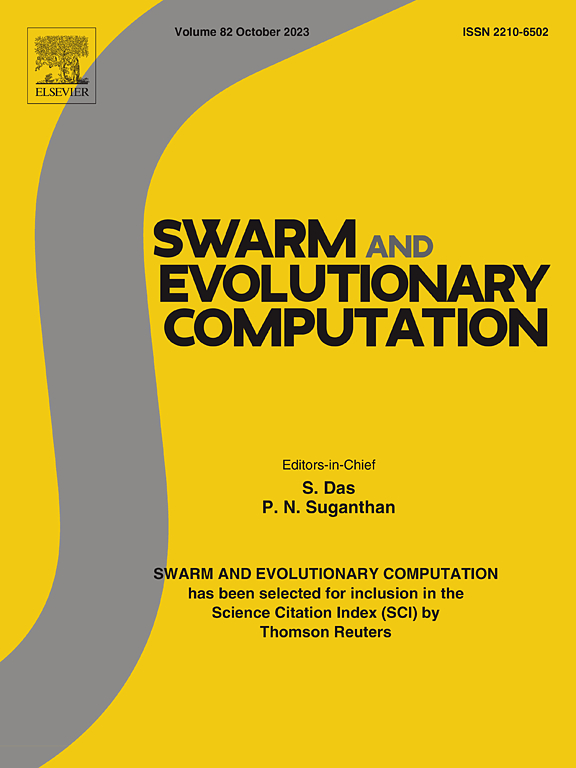基于多目标特征提取和动态集成基模型选择的可解释区间值风电预测系统
IF 8.2
1区 计算机科学
Q1 COMPUTER SCIENCE, ARTIFICIAL INTELLIGENCE
引用次数: 0
摘要
风电预测是实现风电资源优化和可持续发展的重要手段。然而,目前的预测方法主要依赖于信息有限的单值数据,人工智能模型的黑箱性削弱了预测结果的可解释性。本文提出了一种新的区间值风电预测可解释模型,该模型利用特征提取过程、基本模型选择策略和动态集成机制来提高预测精度和可靠性。首先,针对区间值风电数据的复杂性,设计了一种可解释的多目标特征提取方法,提取关键的趋势和波动特征,便于特征及其相互关系的深度学习。考虑到特征与模型的一致性,结合弹性网络回归和Shapley加性解释方法,量化各基模型对预测目标的贡献,以高可解释性的方式选择不同特征序列下的基模型。最后,根据Shapley值动态调整基模型权重,以适应单个模型精度的时变特性,实现在线更新预测。实证研究表明,该模型优于基准模型,具有良好的预测性能和可解释性。本文章由计算机程序翻译,如有差异,请以英文原文为准。
An interpretable interval-valued wind power prediction system based on multi-objective feature extraction and base model selection with dynamic ensemble
Wind power forecasting is essential for resource optimization and sustainable development. However, current forecasting methods mainly rely on single-valued data with limited information, and the black-box nature of artificial intelligence models weakens the interpretability of the prediction results. This paper introduces a new interpretable model for interval-valued wind power forecasting, which enhances prediction accuracy and reliability by leveraging a feature extraction process, a base model selection strategy, and a dynamic ensemble mechanism. First, to address the complexity of interval-valued wind power data, an interpretable multi-objective feature extraction method is designed to distill key trend and fluctuation features, facilitating in-depth learning of features and their relationships. Considering the alignment between features and models, the contribution of each base model to the prediction target is quantified by combining elastic net regression and Shapley additive explanation method, so as to select the base models under different feature sequences in a highly interpretable way. Finally, the base model weights are dynamically adjusted according to the Shapley values to adapt to the time-varying characteristics of individual model accuracy and realize the online update prediction. An empirical study shows that the suggested model outperforms the benchmark model, demonstrating excellent prediction performance and interpretability.
求助全文
通过发布文献求助,成功后即可免费获取论文全文。
去求助
来源期刊

Swarm and Evolutionary Computation
COMPUTER SCIENCE, ARTIFICIAL INTELLIGENCEC-COMPUTER SCIENCE, THEORY & METHODS
CiteScore
16.00
自引率
12.00%
发文量
169
期刊介绍:
Swarm and Evolutionary Computation is a pioneering peer-reviewed journal focused on the latest research and advancements in nature-inspired intelligent computation using swarm and evolutionary algorithms. It covers theoretical, experimental, and practical aspects of these paradigms and their hybrids, promoting interdisciplinary research. The journal prioritizes the publication of high-quality, original articles that push the boundaries of evolutionary computation and swarm intelligence. Additionally, it welcomes survey papers on current topics and novel applications. Topics of interest include but are not limited to: Genetic Algorithms, and Genetic Programming, Evolution Strategies, and Evolutionary Programming, Differential Evolution, Artificial Immune Systems, Particle Swarms, Ant Colony, Bacterial Foraging, Artificial Bees, Fireflies Algorithm, Harmony Search, Artificial Life, Digital Organisms, Estimation of Distribution Algorithms, Stochastic Diffusion Search, Quantum Computing, Nano Computing, Membrane Computing, Human-centric Computing, Hybridization of Algorithms, Memetic Computing, Autonomic Computing, Self-organizing systems, Combinatorial, Discrete, Binary, Constrained, Multi-objective, Multi-modal, Dynamic, and Large-scale Optimization.
 求助内容:
求助内容: 应助结果提醒方式:
应助结果提醒方式:


